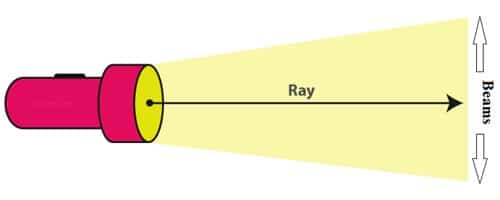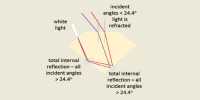A ray of light or light rays are the direction along which the light energy travels. In practice, a ray has a finite width and is represented in diagrams as straight lines. The direction along which, light energy travels in a medium is called a ray of light. It is represented by a straight line with an arrow marked on it.
A beam of light is a collection of rays. A group of light rays is called a beam of light. A searchlight emits a parallel beam of light (Fig: a). Light from a lamp travels in all directions which is a divergent beam. (Fig: b). A convex lens produces a convergent beam of light, when a parallel beam falls on it (Fig: c). A beam of light may be parallel, convergent or divergent.

The terms ‘ray’ mean entities that carry energy through space. A ray only conveys the direction of light. The term ‘beam’ is generally used to explain a horizontal column of radiation. So, ‘Ray’ does not say how spread out the radiation is, it could be dispersal out in all directions, whereas the term ‘beam’ is used when the radiation is restricted to a column. It refers to an optical wave that has a finite width. Think of a laser beam or the beam coming from a flashlight.

It is important to understand that the ray and beam are artificial constructs. Ordinarily, the term ‘ray’ refers to a narrow stream of light energy, e.g., that coming through a little hole in a screen, but systematically it has a more particular meaning. It says nothing about what kind of beam the light is. A ray is the course of the path taken by light. A beam is a stream of light energy and may be represented by a number of rays that might be diverging, converging or parallel. Examples of each of these will be met within due course.














